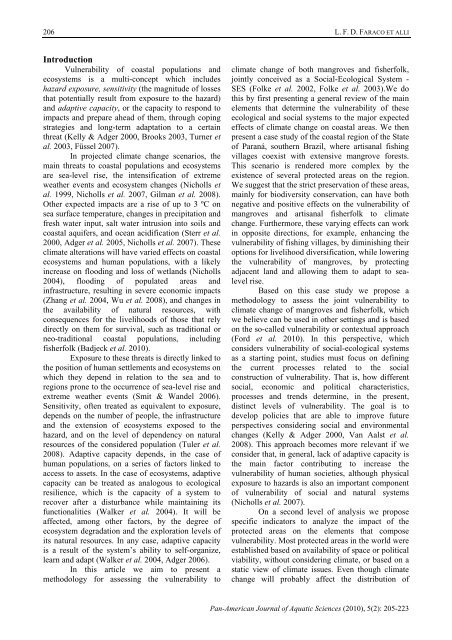Download full issue - PanamJAS
Download full issue - PanamJAS
Download full issue - PanamJAS
- No tags were found...
You also want an ePaper? Increase the reach of your titles
YUMPU automatically turns print PDFs into web optimized ePapers that Google loves.
206L. F. D. FARACO ET ALLIIntroductionVulnerability of coastal populations andecosystems is a multi-concept which includeshazard exposure, sensitivity (the magnitude of lossesthat potentially result from exposure to the hazard)and adaptive capacity, or the capacity to respond toimpacts and prepare ahead of them, through copingstrategies and long-term adaptation to a certainthreat (Kelly & Adger 2000, Brooks 2003, Turner etal. 2003, Füssel 2007).In projected climate change scenarios, themain threats to coastal populations and ecosystemsare sea-level rise, the intensification of extremeweather events and ecosystem changes (Nicholls etal. 1999, Nicholls et al. 2007, Gilman et al. 2008).Other expected impacts are a rise of up to 3 ºC onsea surface temperature, changes in precipitation andfresh water input, salt water intrusion into soils andcoastal aquifers, and ocean acidification (Sterr et al.2000, Adger et al. 2005, Nicholls et al. 2007). Theseclimate alterations will have varied effects on coastalecosystems and human populations, with a likelyincrease on flooding and loss of wetlands (Nicholls2004), flooding of populated areas andinfrastructure, resulting in severe economic impacts(Zhang et al. 2004, Wu et al. 2008), and changes inthe availability of natural resources, withconsequences for the livelihoods of those that relydirectly on them for survival, such as traditional orneo-traditional coastal populations, includingfisherfolk (Badjeck et al. 2010).Exposure to these threats is directly linked tothe position of human settlements and ecosystems onwhich they depend in relation to the sea and toregions prone to the occurrence of sea-level rise andextreme weather events (Smit & Wandel 2006).Sensitivity, often treated as equivalent to exposure,depends on the number of people, the infrastructureand the extension of ecosystems exposed to thehazard, and on the level of dependency on naturalresources of the considered population (Tuler et al.2008). Adaptive capacity depends, in the case ofhuman populations, on a series of factors linked toaccess to assets. In the case of ecosystems, adaptivecapacity can be treated as analogous to ecologicalresilience, which is the capacity of a system torecover after a disturbance while maintaining itsfunctionalities (Walker et al. 2004). It will beaffected, among other factors, by the degree ofecosystem degradation and the exploration levels ofits natural resources. In any case, adaptive capacityis a result of the system’s ability to self-organize,learn and adapt (Walker et al. 2004, Adger 2006).In this article we aim to present amethodology for assessing the vulnerability toclimate change of both mangroves and fisherfolk,jointly conceived as a Social-Ecological System -SES (Folke et al. 2002, Folke et al. 2003).We dothis by first presenting a general review of the mainelements that determine the vulnerability of theseecological and social systems to the major expectedeffects of climate change on coastal areas. We thenpresent a case study of the coastal region of the Stateof Paraná, southern Brazil, where artisanal fishingvillages coexist with extensive mangrove forests.This scenario is rendered more complex by theexistence of several protected areas on the region.We suggest that the strict preservation of these areas,mainly for biodiversity conservation, can have bothnegative and positive effects on the vulnerability ofmangroves and artisanal fisherfolk to climatechange. Furthermore, these varying effects can workin opposite directions, for example, enhancing thevulnerability of fishing villages, by diminishing theiroptions for livelihood diversification, while loweringthe vulnerability of mangroves, by protectingadjacent land and allowing them to adapt to sealevelrise.Based on this case study we propose amethodology to assess the joint vulnerability toclimate change of mangroves and fisherfolk, whichwe believe can be used in other settings and is basedon the so-called vulnerability or contextual approach(Ford et al. 2010). In this perspective, whichconsiders vulnerability of social-ecological systemsas a starting point, studies must focus on definingthe current processes related to the socialconstruction of vulnerability. That is, how differentsocial, economic and political characteristics,processes and trends determine, in the present,distinct levels of vulnerability. The goal is todevelop policies that are able to improve futureperspectives considering social and environmentalchanges (Kelly & Adger 2000, Van Aalst et al.2008). This approach becomes more relevant if weconsider that, in general, lack of adaptive capacity isthe main factor contributing to increase thevulnerability of human societies, although physicalexposure to hazards is also an important componentof vulnerability of social and natural systems(Nicholls et al. 2007).On a second level of analysis we proposespecific indicators to analyze the impact of theprotected areas on the elements that composevulnerability. Most protected areas in the world wereestablished based on availability of space or politicalviability, without considering climate, or based on astatic view of climate <strong>issue</strong>s. Even though climatechange will probably affect the distribution ofPan-American Journal of Aquatic Sciences (2010), 5(2): 205-223
















